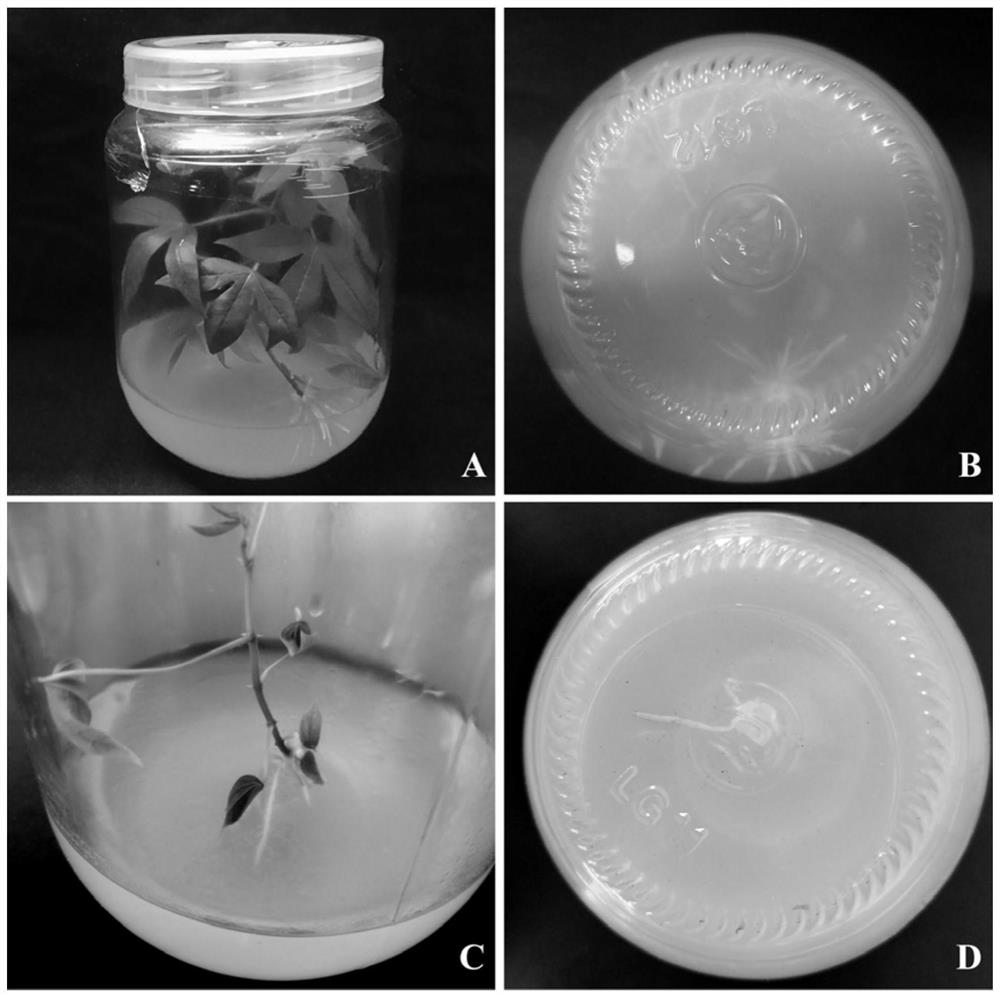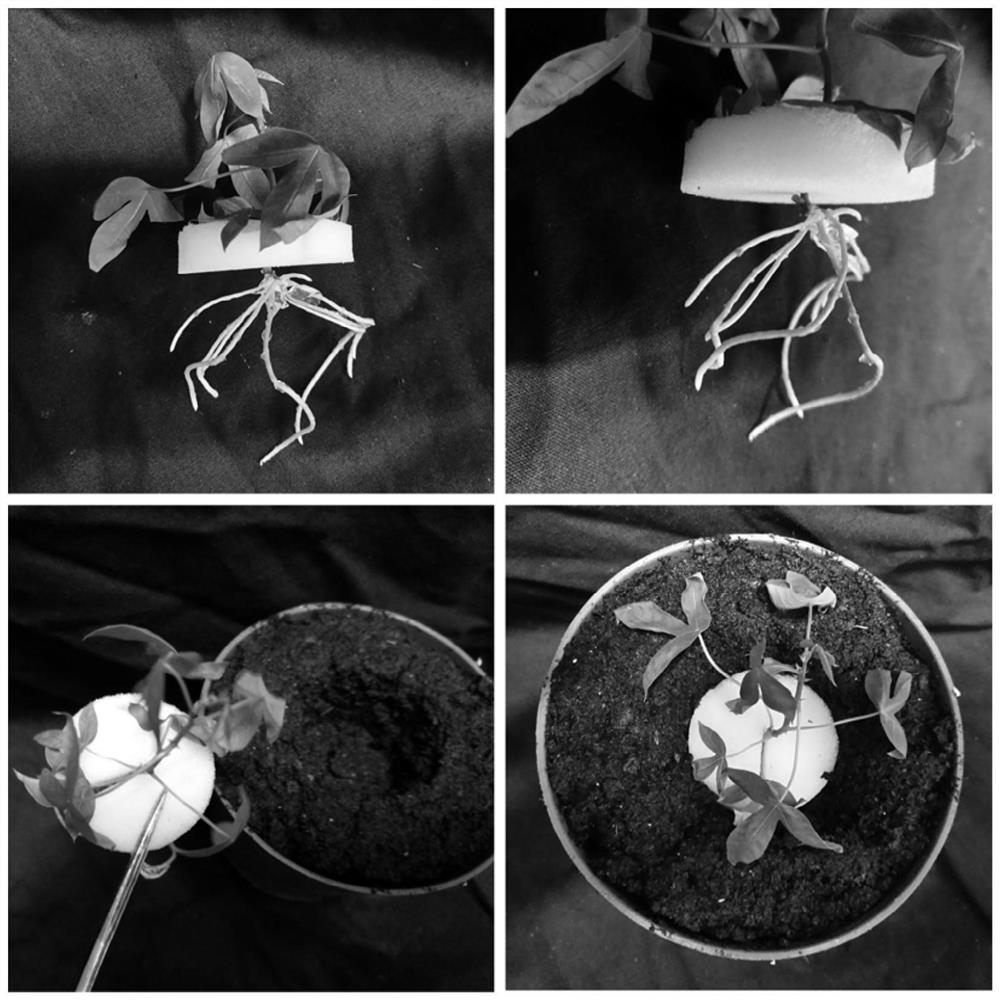A Seedling Hardening Method for Significantly Improving the Transplanting Survival Rate of Cassava Tissue Cultured Seedlings
A technique for transplanting survival rate and tissue culture seedlings, applied in horticultural methods, botanical equipment and methods, cultivation and other directions, can solve problems such as poor soil adaptability, low survival rate, lodging of stems, etc., and reduce foliar transpiration. , The root system is thick and developed, and the leaves are dark green and lush.
- Summary
- Abstract
- Description
- Claims
- Application Information
AI Technical Summary
Problems solved by technology
Method used
Image
Examples
Embodiment 1
[0025] Embodiment one: a kind of hardening method that significantly improves the transplanting survival rate of cassava tissue-cultured seedlings comprises the following steps: (1) selection and breeding: the cassava tissue-cultured seedlings grown for 50 to 60 days are cut into 1.5 to 2.5 cm test tubes Seedling stems, and keep the leaves on the stems, subcultured in seedling culture medium (MS basic medium + 0.1mg / L paclobutrazol pp333) for 33 to 37 days to obtain cassava tissue culture seedlings suitable for transplanting. The average seedling height of the tissue cultured seedlings was 5.24cm, and the growth was good, the leaves were dark green, the stems were thick and thick, the roots were short and strong, the average root system length was 2.7cm, and the average root length was 5.45.
[0026] (2) Colonization: take (1) cassava tissue culture seedlings out of the tissue culture bottle, wash the medium, and be careful not to damage the root system. Then with a diameter o...
Embodiment 2
[0029] Embodiment two: the difference with embodiment one is that the concentration of paclobutrazol in the breeding step (1) is respectively MS, MS+0.05mg / L, MS+0.15mg / L, MS+0.2mg / L, MS+0.25mg / L, MS+0.3mg / L, the results are shown in Table 1, within the concentration range of 0-0.25mg / L, with the increase of PP333 concentration, the leaves become thicker, the leaf color deepens, the plant height shortens significantly, and the root system becomes thicker , the number of roots increased significantly; when the concentration of PP333 was in the range of 0.25mg / L to 0.35mg / L, the leaves were dark green and thick, but some leaves would curl and shrink. It shows that with the increase of the concentration of PP333, the tissue culture seedlings will gradually grow stronger, but the concentration is too high, but it will affect the health of the tissue culture seedlings. It can be obtained from the table that adding PP333 at a concentration of 0.1 mg / L can most effectively improve t...
Embodiment 3
[0033]Embodiment three: the difference with embodiment one is that the thickness of the cotton planted in step (2) is respectively 3cm, 2cm, 1.5cm, 0.75cm and 0cm, as shown in Table 2 by experimental result, the cotton planted too thick (more than 1.5cm ), the contact parts between the young stems of cassava seedlings and the planted cotton will rot, causing the leaves to wilt, lodging and eventually die; and the planted cotton is too thin (below 0.75cm), it cannot play a role in fixing, the tissue culture seedlings are easy to lodging, the leaves wilt, the stems The stalk is bent, the root is not strong, the slow seedling stage is delayed, and even dies; while the planted cotton is 1cm, the fixation effect is good, the leaves stand upright, the root grows stably, the slow seedling stage is greatly shortened, and it has strong adaptability and resistance to the environment. inverse.
[0034] Table 2 Effects of different planting cotton thicknesses on cassava tissue culture see...
PUM
 Login to View More
Login to View More Abstract
Description
Claims
Application Information
 Login to View More
Login to View More - R&D
- Intellectual Property
- Life Sciences
- Materials
- Tech Scout
- Unparalleled Data Quality
- Higher Quality Content
- 60% Fewer Hallucinations
Browse by: Latest US Patents, China's latest patents, Technical Efficacy Thesaurus, Application Domain, Technology Topic, Popular Technical Reports.
© 2025 PatSnap. All rights reserved.Legal|Privacy policy|Modern Slavery Act Transparency Statement|Sitemap|About US| Contact US: help@patsnap.com



